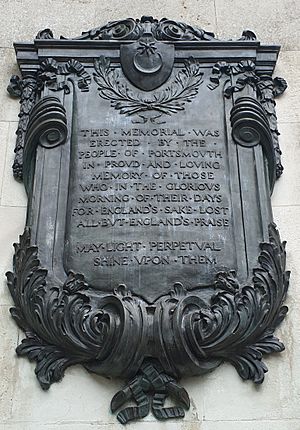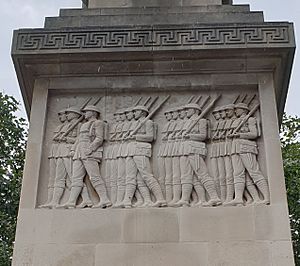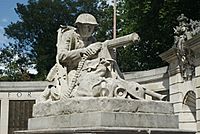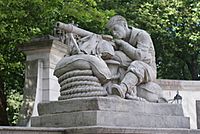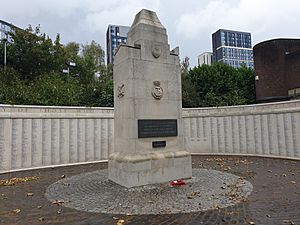Portsmouth War Memorial facts for kids
Quick facts for kids City of Portsmouth War Memorial |
|
|---|---|
| United Kingdom | |
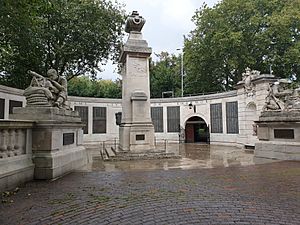 |
|
| For servicemen from Portsmouth killed in the First World War | |
| Unveiled | 19 October 1921 |
| Location | 50°47′52.97″N 1°05′33.55″W / 50.7980472°N 1.0926528°W Guildhall Square, Portsmouth, Hampshire, England
|
| Designed by |
|
|
Listed Building – Grade II
|
|
| Official name | City of Portsmouth War Memorial |
| Designated | 25 September 1972 |
| Reference no. | 1104318 |
The City of Portsmouth War Memorial is also known as the Guildhall Square War Memorial. It is a special monument in Portsmouth, England. This memorial remembers the soldiers, sailors, and airmen from Portsmouth who died in the First World War.
Portsmouth has always been an important port city. It is home to a big naval dockyard. Many people in Portsmouth worked for the navy or in the dockyard. Because of this, the city lost many lives during the First World War.
After the war ended, people in Portsmouth wanted to build a memorial. They chose a spot near the Town Hall (now called the Guildhall). Architects James Gibson and Walter Gordon designed it. The famous sculptor Charles Sargeant Jagger created the statues.
The memorial has a curved, sunken area with a wall. Bronze panels on the wall list the names of those who died. Archways in the wall lead to Victoria Park and the railway station. Statues of a soldier and a sailor stand at the ends of the wall. In the middle is a cenotaph, which is like an empty tomb. It has carvings of war scenes. Prince Arthur officially opened the memorial on 19 October 1921.
The area around the memorial was updated in the 1970s. Later, names of those lost in the Second World War were added. A separate monument for that war was also built. The First World War memorial is a very important historical site. It is a grade II* listed building, meaning it is protected.
Why Portsmouth Needed a Memorial
Remembering War Heroes
After the First World War, many towns and cities in Britain built memorials. This was because so many people had died. Portsmouth was a major port and naval base. Many of its people served in the Royal Navy or British Army.
Before the war, over 25% of working-age men in Portsmouth were in the army or navy. Many more worked at the dockyard. About 6,000 people from Portsmouth died in the war. The city's population was around 200,000 in 1911.
Portsmouth saw its first war casualties in August 1914. This happened when HMS Amphion was sunk by a German mine. One of the biggest losses was during the Battle of Jutland in 1916. This was a huge naval battle. Six Portsmouth-based ships sank at Jutland. About 4,000 lives were lost, many of them local men.
Soldiers from Portsmouth
Portsmouth was also a military town. Soldiers were stationed there to protect the south coast. Others passed through on their way to different parts of the British Empire. In 1914, the 9th Infantry Brigade was based in Portsmouth. They were sent to France at the start of the war.
Portsmouth also had a volunteer army unit called the Territorial Force. Many important town leaders were officers in this group. When Kitchener's Army asked for volunteers, Portsmouth raised two more "pals battalions." These were units where friends and neighbours could serve together. Sadly, more than a third of these volunteers died.
About Charles Sargeant Jagger
Charles Sargeant Jagger (1885–1935) was a sculptor. He joined the army at the start of the First World War. He was wounded several times and received an award for bravery. After the war, he became famous for designing war memorials.
His first memorial was the Hoylake and West Kirby War Memorial. His sculptures for it were highly praised. They showed soldiers in action, not just peaceful figures. This led to many more commissions for memorials. Jagger designed the Great Western Railway War Memorial and the famous Royal Artillery Memorial in London. His sculptures often showed a realistic soldier, known as a "Tommy."
Designing the Memorial
Starting the Project
People in Portsmouth started talking about a memorial right after the war ended. The mayor, John Timpson, asked for ideas and donations in December 1918. To mark the end of the war, the Royal Navy fired a 101-gun salute. Many local churches also held their own services.
A special committee was formed to organize the city's memorial. They decided to build it near the Town Hall. This spot was chosen because it was central and easy to see. It was also close to Victoria Park.
Choosing the Design
The committee held a competition for the memorial's design. Fifty different ideas were submitted. The design by London architects James Gibson and Walter Gordon was chosen. They worked with sculptor Charles Sargeant Jagger for the statues.
A local company won the contract to build the memorial. However, their price of almost £20,000 was too high. The architects had to make the design smaller. They removed some parts, like an arch, several statues, and a fountain. The final cost was £15,808.
Memorial Features
Main Structure
The memorial is made from Portland stone. It has a curved, sunken area called an exedra. This area has a screen wall about 20 feet (6 meters) high. This creates a special, quiet space. Bronze panels are attached to the wall. They list the names of 4,500 people who died. About 500 of these were from the Battle of Jutland.
The names are grouped by military branch. Army names are on the north side, navy names on the south. A smaller section in the middle is for the Royal Air Force. Two arched entrances with iron gates are in the wall. One leads to Victoria Park, the other out of Guildhall Square. Above the panels, it says: "THEIR NAME LIVETH FOR EVERMORE."
Sculptures and Carvings
The wall ends in stone pillars. Each pillar has a seat and a bronze-colored urn. Above these are carvings of weapons and shields. Curved railings extend from the pillars. They end in stone bases with two large sculptures.
One sculpture shows a sailor with a machine gun, representing the navy. The other shows a soldier with a machine gun, representing the army. These figures guard the entrance to the memorial.
The Cenotaph
The main part of the memorial is a cenotaph. This is a monument that looks like a tomb, but it doesn't contain a body. It stands on three steps. Its sides have carvings of wartime scenes. The front shows two warships fighting at sea. The back shows warships fighting a submarine. One side shows a naval gun crew loading a shell. The other side shows marching soldiers. The cenotaph is topped with a large urn.
Inscriptions and Plaques
In the center of the wall is a metal plaque. It reads: "This memorial was erected by the people of Portsmouth in proud and loving memory of those who in the glorious morning of their days for England's sake lost all but England's praise. May light perpetual shine upon them."
Other plaques explain that the memorial was paid for by public donations. In 2003, a stone base was added. It says: "TO HONOUR ALL THOSE WHO DIED SERVING THEIR COUNTRY IN TIMES OF PEACE OR CONFLICT. 'WE WILL REMEMBER' ".
Expert Opinions
Art historian Alan Borg said Jagger's sculptures of the soldiers were "interesting and effective." Geoff Archer, another art historian, called the memorial "a particularly impressive example" of a memorial with a large wall for names.
Historic England described the memorial as "an eloquent tribute" to Portsmouth's service members. They praised its "distinguished design" and Jagger's "accomplished and animated sculpture." They noted Jagger's ability to show the reality of war. The memorial is also important because it is near other historic buildings like the Guildhall and University of Portsmouth.
Memorial History
Building and Unveiling
The first stone of the memorial was laid on 25 May 1921. The memorial was officially opened on 19 October 1921, even though it wasn't fully finished. About 30,000 people attended the ceremony. Prince Arthur, Duke of Connaught and Strathearn led the event.
Money raised for the memorial also helped the Royal Portsmouth Hospital. Some funds improved hospital services. A special memorial gate was also built at the hospital entrance. This gate was opened by Princess Helena Victoria in May 1922. The gate and hospital were later taken down in the late 20th century.
Changes Over Time
In the 1970s, Guildhall Square was redeveloped. The war memorial was made slightly smaller and some parts were moved. A new wall was built next to it.
A separate monument for Second World War casualties was added in 2005. This monument is a rectangular cenotaph. It has carvings of military badges and the city's coat of arms. Princess Alexandra unveiled it. A wall with 610 names was added in 2012 after a local fundraising effort. The last names were added in 2013.
Portsmouth's Royal Navy base and dockyard are still very important today. The memorial is still the main place for the annual Remembrance Sunday services. Many people attend, including members of the armed forces.
The memorial was first protected as a grade II listed building in 1972. It was upgraded to grade II* in 2016. This was to mark 100 years since the Battle of Jutland. Grade II* status means it is a "particularly important building" and is protected from being changed or removed.


